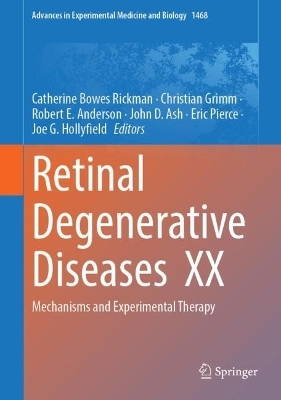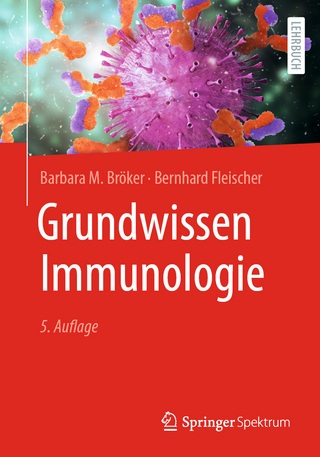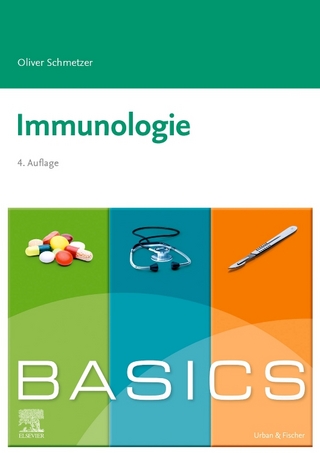
Retinal Degenerative Diseases XX
Springer International Publishing (Verlag)
978-3-031-76549-0 (ISBN)
- Noch nicht erschienen - erscheint am 01.03.2025
- Versandkostenfrei innerhalb Deutschlands
- Auch auf Rechnung
- Verfügbarkeit in der Filiale vor Ort prüfen
- Artikel merken
This book contains the proceedings of the XVIII International Symposium on Retinal Degeneration (RD2018). A majority of those who spoke and presented posters at the meeting contributed to this volume. Most blinding [CG1] diseases of inherited retinal degenerations have no treatments, and age-related macular degeneration has no cures, despite the fact that it is an epidemic among the elderly, with 1 in 3-4 affected by the age of 70. The RD Symposium focused on the exciting new developments aimed at understanding these diseases and providing therapies for them. Since most major scientists in the field of retinal degenerations attend the biennial RD Symposia, they are known by most as the "best" and "most important" meetings in the field.
The volume presents representative state-of-the-art research in almost all areas of retinal degenerations, ranging from cytopathologic, physiologic, diagnostic and clinical aspects; animal models; mechanisms of cell death; candidate genes, cloning, mapping and other aspects of molecular genetics; and developing potential therapeutic measures such as gene therapy and neuroprotective agents for potential pharmaceutical therapy.
Significant advances in these areas of retinal degenerations have been made since the last RD Symposium, RD2021. These include the role of inflammation and immunity, as well as other basic mechanisms, in age-related macular degeneration, several new aspects of gene therapy, and revolutionary new imaging and functional testing that will have a huge impact on the diagnosis and following the course of retinal degenerations, as well as to provide new quantitative endpoints for clinical trials.
The retina is an approachable part of the central nervous system (CNS), and there is a major interest in neuroprotective and gene therapy for CNS diseases and neurodegenerations, in general. It should be noted that with successful and exciting initial clinical trials in neuroprotective and gene therapy, including the restoration of sight in blind children, the retinal degeneration therapies are leading the way towards new therapeutic measures for neurodegenerations of the CNS. Many of the successes recently reported in these areas of retinal degeneration sprang from collaborations established at previous RD Symposia, and many of those were reported at the RD2023 meeting and included in the current volume. We anticipate the excitement of those working in the field and those afflicted with retinal degenerations is reflected in the volume.
Part I: Age-Related Macular Degeneration (AMD).- Associations of the adaptive immune system and age-related macular degeneration.- Macrophages and and age-related macular degeneration.- RPE basal lamina biology and pathophysiology related to age-related macular degeneration.- Genotype-Phenotype Correlations and Genetic Risk Assessment in Age-Related Macular Degeneration.- Photoreceptor degeneration: more than a bystander in age-related macular degeneration.- Cellular Senescence-an emerging player in the pathogenesis of AMD.- Part II - Inherited Retinal Degenerations.- Novel Potentially Pathogenic Variants in TBC1D32 cause Non-syndromic Rod-Cone Degeneration.- The BXD32 Mouse: A High-Fidelity Model of Chronic Retinal Inflammation and Photoreceptor Degeneration.- The challenge of VUS in inherited retinal degeneration: insight from functional studies.- ABCA4 c.5461-6T>C causes Stargardt disease through exon skipping.- Assessment of ABCA4 Genetic Variants: Current Landscape and Future Prospects.- Exploring the Role of ABCA4's ECD2 Domain in Inherited Retinal Degeneration: Computational and Functional Perspectives.- MFRP in early-onset retinal degeneration: Clinical and Molecular Perspectives.- Genetic Landscape of Non-syndromic Retinitis Pigmentosa in Portugal.- Part III: Gene Therapy and Gene Editing.- Frequency and Pattern of Gene Therapy Clinical Trials for Inherited Retinal Diseases.- CRISPR/Cas-mediated gene activation as a versatile tool for treatment of inherited retinal dystrophies.- Prime Editing Strategy to Install the RPE65 c.1430A>G Dominant Mutation.- Megabase deletion of the human EYS locus using CRISPR/Cas9.- Prime Editing Strategy to Install the Mfrp Retinal Degeneration 6 mutation.- Precise Gene Editing Technologies In Retinal Applications.- Part IV: Immunity and Inflammation.- Current perspectives of TLR2 signalling in the retina.- Monocytes in Retinal Degeneration: Little Cells with a Big Impact.- Understanding the different microglia functional states to modulate their activity in retinal degeneration.- Progress in assessing retinal microglia using single-cell RNA sequencing.- The Role of Microglia in Glaucomatous Pathology.- Part V: In-Vivo Imaging for Structure and Function.- Non-invasive assessment of ocular structure in the elderly 13-lined ground squirrel.- Part VI: Mechanisms of Degeneration.- Potential Role of NUR77 in the Aging Retinal Pigment Epithelium and Age-Related Macular Degeneration.- Identification of unexpected pathomechanisms underlying the human Usher syndrome.- The loss of Usher II proteins in mice does not affect photoreceptor ultrastructure.- A role for SARM1 in photoreceptor cell death.- Exploring Histone Modifications in Inherited Retinal Disorders.- Effect of photobiomodulation on proliferative changes in the retina: Evidence from an in vitro model of PVR.- Part VII: Mechanisms of Degeneration - Animal Models.- Calcium binding protein 4 is fundamental for retinal structure and function.- Association between C22:5-containing lipids and RPE Pathologies in Mice with Tmem135 Overexpression.- Extracellular Matrix Gene Expression Patterns in Retinal Wound Healing: A Comparative Study between Mouse and Zebrafish Laser Injury Models.- Zebrafish as a Model for Stargardt Disease.- Fish models of ageing retinal disease.- The power of zebrafish in disease modeling and therapy discovery for inherited retinal degeneration.- Unexpected retinal abnormalities in the cone-dominant northern tree shrew.- Deletion of Pnpla2 Causes Malformation and Malperformance of Mouse Photoreceptors.- Light as a mediator of acute and chronic retina degeneration.- A Knockin Model with the mouse equivalent to the c.2299delG Mutation in usherin Exhibits Early-Onset Hearing Loss and Progressive Retinal Degeneration.- Oxidative stress and energetic failure: common features and dissimilarities in 3 different mouse models of retinal pigment epithelium phagocytosis defects.- Part VIII: Mechanisms of Degeneration - Metabolism.- The connection between cellular metabolism and retinal disease.- Stimulation of Thyroid Hormone Signaling Induces Stress Responses in Mouse Retina.- Ocular Tissue-Specific Amino Acid Metabolism in Gyrate Atrophy.- Part IX: Neuroprotection.- Is Caveolin-1 required for retinal neuroprotection?.- Brain-derived neurotrophic factor in retinal integrity under diabetic and hypoxic conditions.- Part X_ Photoreceptors.- Girdin is a Class I Phosphatidylinositol 3-kinase Binding Protein in the Retina.- Photoreceptor disc morphogenesis: who are the conductors of this highly metronomic process?.- Mechanism of photoreceptor outer segment tip ingestion: Evidence of trogocytosis.- The PRPH2 D2 Loop: Biochemical Insights and Implications in Disease.- Vulnerability of the Nrl-/- Cone-Dominant Retina to Endoplasmic Reticulum Stress.- Molecular components of vesicle cycling at the rod photoreceptor ribbon synapse.- Part XI: RPE.- Less is more: the RPE cell culture medium additive THT mildly impairs RPE health.- Desmosome and Hemidesmosome Disassembly in Retinal Pigmented Epithelium - Intersection with the Exosome Pathway.- Signaling pathways in Retinal Pigment Epithelium (RPE) cells in response to stress conditions of Age-Related Macular Degeneration (AMD).- The Importance of Differentiated RPE Cultures to Study Cell Biological Processes.- IGFBP5 as a Novel Basolateral Secretion Marker in the Retinal Pigment Epithelium.- Role of microsomal triglyceride transfer protein (MTP) in lipid processing pathways in retinal pigment epithelium.- Immunogenic switch of RPE cells.- Mitochondrial DNA Damage in the retinal pigmented epithelium (RPE) and its role in RPE pathobiology.- Part XII: Stem Cell Models and Therapies.- Live imaging microscopy of human retina organoids: Photoreceptor pathology.- The Importance of Choriocapillaris Replacement in Therapeutic Strategies for Age-Related Macular Degeneration.- Classifying Mouse RPE Morphometric Heterogeneity Using REShAPE - an AI-based Image Analysis Tool.- Dysregulation of Retinal and Photoreceptor Structural Integrity Genes in ATF6-/- Retinal Organoids.- Engineering specific human iPS reporter cell lines to generate optogenetically modified photoreceptors.- Part XIII: Retinal Cell Biology.- Phosphoinositide 3-Kinase Enhancer Protein: Insights into its Expression and Functions in Retinal Cells.- Expression of Versican in the retina and its implication in retinal disease.- The role of RPE phagocytosis in the retina metabolic ecosystem.- Ocular Localization of Complement Factor H and its Association with Diseases in the Eye.- The Role of Primary Cilia in the Eye.- Key Claudins at the Blood-Retina Barriers.- NUDC is Critical for Mitosis and Postmitotic Cell Maintenance Through its Modulation of Dynein and Actin Cytoskeletal Reorganization.- Interplay of Retinal and Choroidal Vasculatures in Ocular Health and Disease.- Genetically encoded metabolic sensors to study retina metabolism.- Riboflavin, retbindin and riboflavin transporters in the retina.- Critical Roles of SEA Domains.- Part XIV: Drug and Other Therapies.- Targeting connexins biology as therapeutic strategies against retinal diseases.- Uncovering Novel Drugs that Restore Vision Using Orthogonal Pooling in Zebrafish.- Steroid-Nitroxide Hybrid Compound Protects the Retina in a Model of CNV.- Part XV: Human Studies.- Artificial Intelligence-assisted Matching of Human Postmortem Donors to Ocular Research Projects.- Late-Onset Retinal Degeneration: clinical features and C1QTNF5/CTRP5 function.
| Erscheint lt. Verlag | 1.3.2025 |
|---|---|
| Reihe/Serie | Advances in Experimental Medicine and Biology |
| Zusatzinfo | X, 530 p. 90 illus., 68 illus. in color. |
| Verlagsort | Cham |
| Sprache | englisch |
| Maße | 178 x 254 mm |
| Themenwelt | Medizin / Pharmazie ► Medizinische Fachgebiete ► Augenheilkunde |
| Studium ► Querschnittsbereiche ► Infektiologie / Immunologie | |
| Naturwissenschaften ► Biologie ► Humanbiologie | |
| Schlagworte | Degeneration • gene therapy • macular degeneration • photoreceptor regneration • retina |
| ISBN-10 | 3-031-76549-4 / 3031765494 |
| ISBN-13 | 978-3-031-76549-0 / 9783031765490 |
| Zustand | Neuware |
| Informationen gemäß Produktsicherheitsverordnung (GPSR) | |
| Haben Sie eine Frage zum Produkt? |
aus dem Bereich


